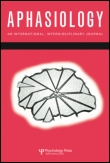
APHASIOLOGY
Scope & Guideline
Pioneering Knowledge in Linguistics and Neurology
Introduction
Aims and Scopes
- Aphasia Assessment and Measurement:
Research on various assessment tools and their psychometric properties, including adaptations for different languages and cultures. - Therapeutic Interventions:
Studies examining the efficacy of diverse therapeutic approaches for individuals with aphasia, including traditional speech therapy, technology-assisted interventions, and novel methodologies. - Communication and Quality of Life:
Exploration of how aphasia affects interpersonal communication, relationships, and overall quality of life for individuals and their families. - Neurocognitive Mechanisms:
Investigations into the neural correlates of language processing and recovery in aphasia, informed by neuroimaging and electrophysiological methods. - Bilingualism and Multilingualism:
Research focusing on the implications of bilingualism in aphasia recovery, including language mixing and cross-language transfer. - Qualitative Research:
Qualitative studies exploring the lived experiences of individuals with aphasia and their caregivers, including perspectives on therapy and rehabilitation.
Trending and Emerging
- Telepractice and Digital Interventions:
The increasing use of telepractice and digital tools for aphasia therapy has gained significant attention, especially in the context of remote healthcare delivery post-COVID-19. - Interdisciplinary Approaches:
There is a growing trend towards integrating insights from psychology, neuroscience, and technology to enhance aphasia rehabilitation. - Person-Centered Care:
Research focusing on the needs, values, and preferences of individuals with aphasia and their families is on the rise, emphasizing a more holistic approach to therapy. - Augmentative and Alternative Communication (AAC):
The exploration of AAC methods and technologies is expanding, highlighting their role in supporting communication for individuals with severe aphasia. - Longitudinal Studies and Recovery Trajectories:
An increase in longitudinal studies examining the long-term recovery trajectories of individuals post-stroke is evident, providing insights into the chronic phase of aphasia rehabilitation.
Declining or Waning
- Traditional Linguistic Models:
There is a noticeable decrease in studies strictly adhering to traditional linguistic models without considering the broader psychosocial context of aphasia. - Pharmacological Interventions:
Research on pharmacotherapy for aphasia has diminished, possibly due to a growing emphasis on behavioral and rehabilitative approaches over medical treatments. - Generalized Aphasia Interventions:
There is a waning interest in generalized interventions that do not tailor to specific aphasia types or individual needs, as more personalized approaches gain traction. - Static Assessment Tools:
The use of static assessment tools that do not adapt to the dynamic nature of recovery and rehabilitation in aphasia is becoming less common. - Aphasia-focused Public Awareness Campaigns:
While public awareness of aphasia remains important, fewer studies are dedicated to evaluating the effectiveness of awareness campaigns in recent years.
Similar Journals
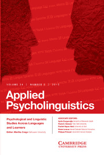
APPLIED PSYCHOLINGUISTICS
Charting New Territories in Experimental PsycholinguisticsApplied Psycholinguistics, published by Cambridge University Press, is a premier journal in the fields of linguistics, psychology, and cognitive science, with a focus on the intersection of language and psychological processes. Since its inception in 1980, the journal has consistently provided a platform for high-quality research, achieving impressive rankings in various categories as of 2023, including Q1 status in Linguistics and Language, and Q1 in Psychology (miscellaneous). With a focus on experimental and cognitive psychology, it fosters the exploration of language acquisition, social communication, and cognitive mechanisms underlying language use. Although it is not available as an Open Access journal, its rigorous peer-review process and impactful articles make it a significant resource for researchers, professionals, and students alike. The journal's commitment to advancing knowledge is evident through its contributions to both theoretical and applied psycholinguistic research. Whether you're a seasoned researcher or a student eager to delve into psycholinguistics, this journal serves as an essential resource for keeping abreast of cutting-edge developments in the discipline.
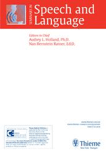
SEMINARS IN SPEECH AND LANGUAGE
Fostering collaboration in the world of speech and language.SEMINARS IN SPEECH AND LANGUAGE, published by Thieme Medical Publishers Inc, is a distinguished journal established to advance the study and practice of speech and language pathology. Boasting ISSN 0734-0478 and E-ISSN 1098-9056, this journal has carved a niche in the fields of speech and hearing, and nursing, holding impressive ranks in the latest Scopus categorization. With an impact factor that reflects its growing influence, SEMINARS IN SPEECH AND LANGUAGE serves as a platform for the dissemination of cutting-edge research, clinical practices, and innovative therapies, aiming to support professionals, researchers, and students alike. It provides critical insights aimed at enhancing patient outcomes and driving forward the science of communication disorders. Covering the period from 1984 to 2024, this journal continues to thrive in its mission to foster collaboration and knowledge-sharing within the community.
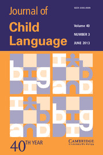
JOURNAL OF CHILD LANGUAGE
Bridging Psychology and Linguistics in Child Language StudiesJOURNAL OF CHILD LANGUAGE, published by Cambridge University Press, is a premier scholarly journal dedicated to the exploration and examination of language development in children. Since its inception in 1974, the journal has become an authoritative source in the fields of Developmental and Educational Psychology, Experimental and Cognitive Psychology, and Linguistics, boasting significant impact as evidenced by its ranking in the top quartiles across these domains. With an impressive impact factor and a commitment to advancing research, the journal serves as a vital platform for researchers, educators, and practitioners interested in the intricacies of language acquisition and cognitive development in children. The 2023 Category Quartiles place it in Q1 for Linguistics and Language, further establishing its excellence. Fostering a rich intellectual community, the journal invites contributions that advance our understanding of child language, promising a broad readership in both the social sciences and humanities.
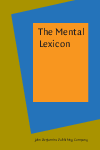
Mental Lexicon
Bridging Cognitive Neuroscience and Linguistic TheoryMental Lexicon is a leading academic journal published by JOHN BENJAMINS PUBLISHING CO that spans significant interdisciplinary terrains including Cognitive Neuroscience and Linguistics. Since its inception in 2006, the journal has gained a prestigious reputation, currently holding a Q1 tier in Linguistics and Language and a Q3 rating in Cognitive Neuroscience based on 2023 categorizations. With impressive Scopus rankings—247 out of 1088 in Language and Linguistics and 94 out of 115 in Cognitive Neuroscience—it serves as a critical platform for the dissemination of innovative research and theoretical advancements in mental lexicon studies. The journal fosters an environment for scholars, researchers, and students to explore the complexities of language processing and cognitive functions, thereby contributing to the realization of our understanding of the mind and language. While Mental Lexicon operates under closed access, it remains an essential resource for those seeking to delve into the intricate relationship between linguistic capabilities and cognitive processes.

Communication Sciences and Disorders-CSD
Shaping the landscape of speech-language pathology research.Communication Sciences and Disorders-CSD, published by the Korean Academy of Speech-Language Pathology & Audiology, is a pivotal academic journal dedicated to the fields of communication sciences, speech-language pathology, and audiology. With an ISSN of 2288-1328 and an E-ISSN of 2288-0917, this journal has been contributing to the body of knowledge since 2013 and is set to continue its impactful journey through 2024. The journal is recognized for its rigorous research and maintains respectable rankings within various categories, achieving a Q2 in Linguistics and Language and Q3 in Communication, Speech, and Hearing for 2023. It offers valuable insights for researchers and professionals committed to advancing understanding and treatment in communication disorders. Though currently not open access, the journal provides robust academic resources that are essential for those striving to innovate and enhance practices in speech and hearing disciplines in South Korea and beyond.
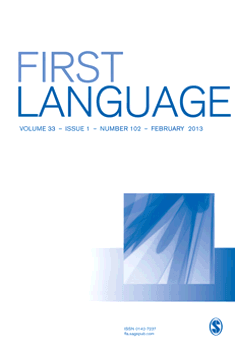
First Language
Elevating Research in Language AcquisitionFirst Language is a prestigious journal dedicated to the study of language acquisition, development, and use, published by SAGE Publications Ltd. With an ISSN of 0142-7237 and E-ISSN 1740-2344, this journal has been a vital resource in the fields of Education and Linguistics since its inception in 1980. It proudly holds a 2023 Q1 ranking in Linguistics and Language and a Q2 ranking in Education, underscoring its significant impact and contribution to these dynamic fields. Positioned in the 91st and 90th percentiles in Scopus rankings for Language and Linguistics and Social Sciences, respectively, First Language attracts a global readership, fostering rigorous scholarly discussion and exploration. The journal is not Open Access, ensuring that its curated content maintains a high level of academic integrity and exclusivity. With a rich historical scope extending to 2024, First Language serves as an essential platform for researchers, practitioners, and students committed to advancing our understanding of language in all its complexities.

JOURNAL OF FLUENCY DISORDERS
Transforming research into practice for fluency disorders.JOURNAL OF FLUENCY DISORDERS, published by Elsevier Science Inc, is a pivotal peer-reviewed journal that has been advancing the field of speech and language pathology since its inception in 1974. With a focus on fluency disorders, this journal aims to disseminate high-quality research that deepens understanding and fosters innovation in interventions and therapeutic practices. Renowned for its high Impact Factor and categorized in the Q1 and Q2 quartiles across several academic domains including Linguistics and Language, Speech and Hearing, and Cognitive Neuroscience, it stands as a vital resource for researchers and practitioners alike. The journal features both theoretical and empirical studies, addressing clinical practices, educational approaches, and the underlying cognitive mechanisms of fluency disorders. While it does not offer an open-access option, it remains accessible through institutional subscriptions and individual memberships. By fostering a rich dialogue within the community, the JOURNAL OF FLUENCY DISORDERS serves as a cornerstone for advancing the understanding and treatment of fluency disorders, ultimately improving outcomes for individuals affected by these challenges.
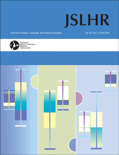
JOURNAL OF SPEECH LANGUAGE AND HEARING RESEARCH
Exploring breakthroughs in communication sciences.JOURNAL OF SPEECH LANGUAGE AND HEARING RESEARCH, published by the American Speech-Language-Hearing Association, is a premier peer-reviewed journal dedicated to advancing the fields of speech, language, and hearing sciences. With an impressive impact factor and a strong ranking within the Q1 category of Linguistics and Language and Speech and Hearing, this journal serves as a vital resource for academics and professionals seeking to disseminate groundbreaking research and innovative practices in communication disorders. The journal, which spans actively from 1996 to 2024, offers Open Access options, facilitating broader distribution of knowledge within the scientific community. As evident from its esteemed rankings—such as #11/66 in Health Professions: Speech and Hearing—this journal not only drives forward the knowledge frontiers but also plays a crucial role in shaping policy and practice in health services. Researchers, clinicians, and students alike will find invaluable insights and empirically supported advancements within its pages, making it an essential publication in the landscape of communication and health research.
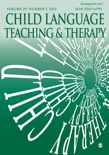
Child Language Teaching & Therapy
Championing high-quality research in child language teaching.Child Language Teaching & Therapy is a premier journal published by SAGE Publications Ltd, dedicated to advancing the field of child language development and intervention. With its ISSN 0265-6590 and E-ISSN 1477-0865, this interdisciplinary journal has been pivotal since its inception in 1985 and continues to set academic standards through 2024. The journal holds a significant reputation within the Q3 quartile categories in Clinical Psychology, Developmental and Educational Psychology, and Education, alongside an esteemed Q1 designation in Linguistics and Language. Its Scopus rankings underscore its influence, particularly in the Arts and Humanities and Social Sciences domains, with remarkable percentiles that reflect its commitment to fostering high-quality research and innovation in child language teaching and therapy. Though not open access, it remains a vital resource for researchers, clinicians, and educators who seek to understand and enhance communication practices among children. By disseminating empirical studies, theoretical discussions, and practical applications, this journal plays a crucial role in bridging the gap between academic inquiry and real-world application, making it an indispensable asset for practitioners and scholars alike.
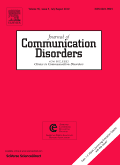
JOURNAL OF COMMUNICATION DISORDERS
Transforming Research into Action for Communication Success.Journal of Communication Disorders (ISSN: 0021-9924; E-ISSN: 1873-7994) is a leading publication in the field of communication disorders, published by Elsevier Science Inc. With a converged publishing timeline from 1967 to 2024, this journal has established itself as a vital resource for researchers, clinicians, and educators dedicated to advancing knowledge in areas such as linguistics, language processing, speech, and hearing. It boasts an impressive reputation, ranking in the Q1 category for Linguistics and Language, and Q1 in LPN and LVN as well as Q2 in Speech and Hearing for 2023, highlighting its influence and scholarly impact within these domains. The journal is recognized for its rigorous peer-reviewed articles and its contributions to our understanding of cognitive neuroscience, experimental psychology, and communication disorders—further evidenced by its ranking in the top percentiles in various fields. Although it does not currently offer Open Access options, readers and contributors alike will appreciate the depth and breadth of research published within its pages. This journal serves an essential role in bridging the gap between research and practical application, making it a must-read for anyone involved in the study or treatment of communication disorders.